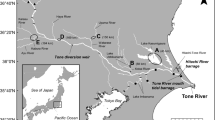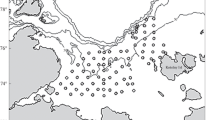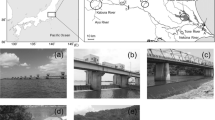Abstract
To investigate the population dynamics of naturally recruited wild Japanese eels, fisheries data of wild individuals in Okayama Prefecture were investigated as a case study. Wild and stocked eels were discriminated using a recently developed method based on otolith stable isotopes. Of the 161 eels captured in freshwater areas where eels had been stocked, 98.1% were discriminated as stocked. In contrast, 82.8% of 128 eels captured in coastal areas where eels are not stocked were discriminated as wild. There was a significant decrease in longline and set-net catch per unit effort between 2003 and 2016 in the coastal areas where most eels were discriminated as wild, indicating ongoing depletion of wild Japanese eels in these waters.


(modified from Kaifu et al. 2017). Lines indicate standard deviations (color figure online)



Similar content being viewed by others
References
Arai T, Kotake A, Ohji M, Miller MJ, Tsukamoto K, Miyazaki N (2003) Occurrence of sea eels of Anguilla japonica along the Sanriku Coast of Japan. Ichthyol Res 50:78–81
Han YS, Hung CL, Tzeng WN (2010) Population genetic structure of the Japanese eel Anguilla japonica: panmixia at spatial and temporal scales. Mar Ecol Prog Ser 401:221–232
ICES (2016) Report of the Workshop on Eel Stocking, Toomebridge
Itakura H, Miyake Y, Kitagawa T, Kimura S (2018) Site fidelity, diel and seasonal activities of yellow-phase Japanese eels (Anguilla japonica) in a freshwater habitat as inferred from acoustic telemetry. Ecol Freshw Fish. https://doi.org/10.1111/eff.12389
Jacoby D, Gollock M (2014) Anguilla japonica. The IUCN Red List of Threatened Species. Version 2014.3, e.T166184A1117791. https://doi.org/10.2305/IUCN.UK.2014-1.RLTS.T166184A1117791.en
Kaifu K, Tamura M, Aoyama J, Tsukamoto K (2010) Dispersal of yellow phase Japanese eels Anguilla japonica after recruitment in the Kojima Bay-Asahi River system, Japan. Environ Biol Fish 88:273–282
Kaifu K, Maeda H, Yokouchi K, Sudo R, Miller MJ, Aoyama J, Yoshida T, Tsukamoto K, Washitani I (2014) Do Japanese eels recruit into the Japan Sea coast?: a case study in the Hayase River system, Fukui Japan. Environ Biol Fish 97:921–928
Kaifu K, Itakura H, Amano Y, Shirai K, Yokouchi K, Wakiya R, Murakami-Sugihara N, Washitani I, Yada T (2017) Discrimination of wild and cultured Japanese eels based on otolith stable isotope ratios. ICES J Mar Sci 75:719–726
Kim ST, Mucci A, Taylor BE (2007) Phosphoric acid fractionation factors for calcite and aragonite between 25 and 75 C: revisited. Chem Geol 246:135–146
Kubota K, Shirai K, Murakami-Sugihara N, Seike K, Hori M, Tanabe K (2017) Annual shell growth pattern of the Stimpson’s hard clam Mercenaria stimpsoni as revealed by sclerochronological and oxygen stable isotope measurements. Palaeogeogr Palaeoclimatol Palaeoecol 465:307–315
Minegishi Y, Aoyama J, Yoshizawa N, Tsukamoto K (2012) Lack of genetic heterogeneity in the Japanese eel based on a spatiotemporal sampling. Coastal Mar Sci 35:269–276
Ministry of the Environment Japan (2015) Report of commissioned affairs to consider conservation measures for Japanese eel in Heisei 26. (in Japanese)
Ministry of the Environment of Japan (2016) Report of commissioned affairs to consider conservation measures for Japanese eel in Heisei 27. (in Japanese)
Okamura A, Yamada Y, Yokouchi K, Horie N, Mikawa N, Utoh T, Tanaka S, Tsukamoto K (2007) A silvering index for the Japanese eel Anguilla japonica. Environ Biol Fish 80:77–89
Prigge E, Marohn L, Hanel R (2013) Tracking the migratory success of stocked European eels Anguilla anguilla in the Baltic Sea. J Fish Biol 82:686–691
Shiraishi H, Crook V (2015) Eel market dynamics: an analysis of Anguilla production, trade and consumption in East Asia. Traffic, Tokyo. http://www.traffic.org/publications/eel-market-dynamics-an-analysis-of-anguilla-production-trade.html
Sudo R, Okamura A, Fukuda N, Miller MJ, Tsukamoto K (2017) Environmental factors affecting the onset of spawning migrations of Japanese eels (Anguilla japonica) in Mikawa Bay, Japan. Environ Biol Fish 100:237–249
Tanaka E (2014) Stock assessment of Japanese eels using Japanese abundance indices. Fish Sci 80:1129–1144
Tsukamoto K (1990) Recruitment mechanism of the eel, Anguilla japonica, to the Japanese coast. J Fish Biol 36:659–671
Tsukamoto K, Chow S, Otake T, Kurogi H, Mochioka N, Miller MJ, Aoyama J, Kimura S, Watanabe S, Yoshinaga T, Shinoda A, Kuroki M, Oya M, Watanabe T, Hata K, Ijiri S, Kazeto Y, Nomura K, Tanaka H (2011) Oceanic spawning ecology of freshwater eels in the western North Pacific. Nat Commun 2:1–9
Wakiya R, Kaifu K, Mochioka N (2016) Growth conditions after recruitment determine residence–emigration tactics of female Japanese eels Anguilla japonica. Fish Sci 82:729–736
Westin L (2003) Migration failure in stocked eels Anguilla anguilla. Mar Ecol Prog Ser 254:307–311
Yokouchi K, Fukuda N, Miller MJ, Aoyama J, Daverat F, Tsukamoto K (2012) Influences of early habitat use on the migratory plasticity and demography of Japanese eels in central Japan. Estuar Coast Shelf Sci 107:132–140
Acknowledgements
We are grateful to the Okayama Inland, Iri, and Okayama-shi Fisheries Cooperatives for their support during eel sampling. Fisheries data were collected in collaboration with the Okayama Prefectural Technology Center for Agriculture, Forestry and Fisheries Research Institute for Fisheries Science. This study was funded by the Research Project of Japanese Eel Habitat, implemented by the Fisheries Agency of Japan, Conference for Restoration of the Takahashi-River Ecosystem, and Chuo University.
Author information
Authors and Affiliations
Corresponding author
Rights and permissions
About this article
Cite this article
Kaifu, K., Yokouchi, K., Higuchi, T. et al. Depletion of naturally recruited wild Japanese eels in Okayama, Japan, revealed by otolith stable isotope ratios and abundance indices. Fish Sci 84, 757–763 (2018). https://doi.org/10.1007/s12562-018-1225-2
Received:
Accepted:
Published:
Issue Date:
DOI: https://doi.org/10.1007/s12562-018-1225-2




